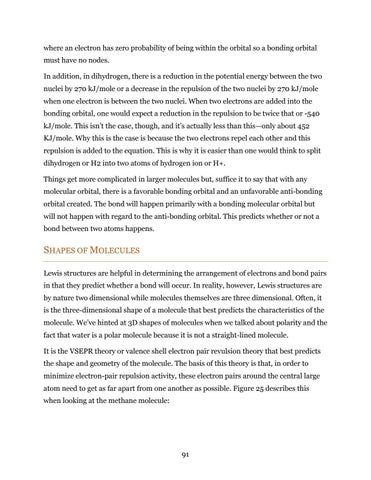where an electron has zero probability of being within the orbital so a bonding orbital must have no nodes. In addition, in dihydrogen, there is a reduction in the potential energy between the two nuclei by 270 kJ/mole or a decrease in the repulsion of the two nuclei by 270 kJ/mole when one electron is between the two nuclei. When two electrons are added into the bonding orbital, one would expect a reduction in the repulsion to be twice that or -540 kJ/mole. This isn’t the case, though, and it’s actually less than this—only about 452 KJ/mole. Why this is the case is because the two electrons repel each other and this repulsion is added to the equation. This is why it is easier than one would think to split dihydrogen or H2 into two atoms of hydrogen ion or H+. Things get more complicated in larger molecules but, suffice it to say that with any molecular orbital, there is a favorable bonding orbital and an unfavorable anti-bonding orbital created. The bond will happen primarily with a bonding molecular orbital but will not happen with regard to the anti-bonding orbital. This predicts whether or not a bond between two atoms happens.
SHAPES OF MOLECULES Lewis structures are helpful in determining the arrangement of electrons and bond pairs in that they predict whether a bond will occur. In reality, however, Lewis structures are by nature two dimensional while molecules themselves are three dimensional. Often, it is the three-dimensional shape of a molecule that best predicts the characteristics of the molecule. We’ve hinted at 3D shapes of molecules when we talked about polarity and the fact that water is a polar molecule because it is not a straight-lined molecule. It is the VSEPR theory or valence shell electron pair revulsion theory that best predicts the shape and geometry of the molecule. The basis of this theory is that, in order to minimize electron-pair repulsion activity, these electron pairs around the central large atom need to get as far apart from one another as possible. Figure 25 describes this when looking at the methane molecule:
91




























